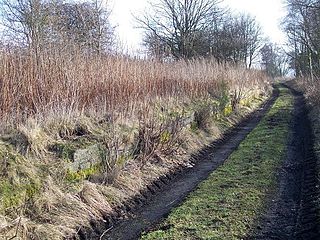
Seahouses is a large village on the North Northumberland coast in England. It is about 20 kilometres (12 mi) north of Alnwick, within the Northumberland Coast Area of Outstanding Natural Beauty.

Highgate is a London Underground station and former railway station in Archway Road, in the London Borough of Haringey in north London. The station takes its name from nearby Highgate Village. It is on the High Barnet branch of the Northern line, between East Finchley and Archway stations, and is in Travelcard Zone 3.

Edgware Station is a London Underground station in Edgware, in the London Borough of Barnet, in North London. The station is the northern terminus of the Edgware branch of the Northern line and the next station towards south is Burnt Oak. Edgware is in Travelcard Zone 5.

The Durham Coast Line is an approximately 39.5-mile (63.6 km) railway line running between Newcastle and Middlesbrough in North East England. Heavy rail passenger services, predominantly operated Northern Trains, and some freight services operate over the whole length of the line; it provides an important diversionary route at times when the East Coast Main Line is closed. Light rail services of the Tyne and Wear Metro's Green Line also operate over the same tracks between a junction just south of Sunderland station and Pelaw Junction.
Elstree South was a proposed London Underground station in Elstree, Hertfordshire. It was designed by Charles Holden. The planned location of the station was adjacent to the A5183, north of the junction with the A41 and where junction 4 of the M1 motorway was subsequently built.

Scotsgap was a stone-built railway station in Northumberland on the Wansbeck Railway, which served the villages of Scots' Gap and Cambo. It was located on the line between Morpeth and Reedsmouth, and was the junction for the branch line of the Northumberland Railway to Rothbury.
Mindrum railway station was a stone built railway station serving the hamlet of Mindrum and the surrounding villages in Northumberland. It was on the Alnwick to Cornhill Branch which ran from Alnwick to Cornhill Junction on the Kelso line near Coldstream.

Woodburn was a stone-built railway station with substantial goods sidings in Northumberland, on the Wansbeck Railway between Morpeth and Reedsmouth. It served the villages of West and East Woodburn plus a local military camp.

Rothbury was a railway station in Northumberland, England at the end of the single-track Rothbury Branch that served the town of Rothbury. Rothbury was the terminus of the line with a turntable at the end of the track.

Middleton North was a stone-built railway station on the Wansbeck Railway between Morpeth and Reedsmouth, which served the villages of Middleton and Hartburn.

Brinkburn was a weatherboard- and corrugated-iron-built railway station in Northumberland on the Rothbury Branch built to serve the Healy Coate Colliery to which it was linked by a two-mile aerial ropeway.

Knowesgate was a stone-built railway station with goods sidings in Northumberland, England on the Wansbeck Railway between Morpeth and Reedsmouth, which served the village of Kirkwhelpington.

Meldon railway station was a stone built railway station with goods sidings in Northumberland on the Wansbeck Railway between Morpeth and Reedsmouth to the south of the village of Meldon.
The North Sunderland Railway was a railway line in Northumberland, England. It was opened in 1898, and ran from Chathill to Seahouses, with an intermediate station at North Sunderland. Chathill was on the main line of the North Eastern Railway between Morpeth and Berwick. The branch was four miles in length and a single track with standard gauge track.
North Sunderland railway station was a brick built station on the single track branch of the North Sunderland Railway, in north east England. The line connected the village and port of Seahouses to the railway network via a junction at Chathill.

West Fleetham is a small hamlet in Northumberland, England situated about 4 miles from Seahouses and 2 miles from Chathill railway station.

Blackhall Colliery railway station served the village of Blackhall Colliery in County Durham, North East England. It was located on the Durham Coast Line, north of Blackhall Rocks and south of Horden.

Wellfield railway station was a railway station built by the North Eastern Railway (NER) on the route of the Hartlepool Dock & Railway (HD&R) to allow interchange between the existing line and their newly opened line from Stockton-on-Tees which had opened to passenger traffic just two years earlier. When first built, the station was located in a rural area, being located immediately to the north of the bridge carrying the Durham to Hartlepool road over the railway line. However the village of Wingate in County Durham, North East England gradually expanded northwards over the course of the station's life and as a result, the station became one of two to serve the village. It was also located only a relatively short distance from the Castle Eden Brewery and thus served the northern district of Castle Eden that surrounds it.

Ryhoperailway station was one of two railway stations to have served the village of Ryhope, Tyne & Wear. For much of its existence, it was served by the Durham–Sunderland and Hartlepool–Haswell–Sunderland lines.

Hart railway station was a station that served the villages of Hart and Crimdon in County Durham, England.
















